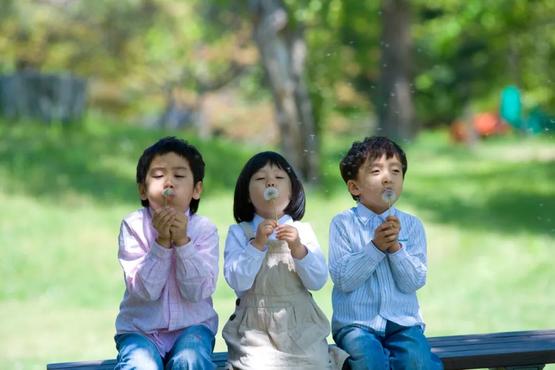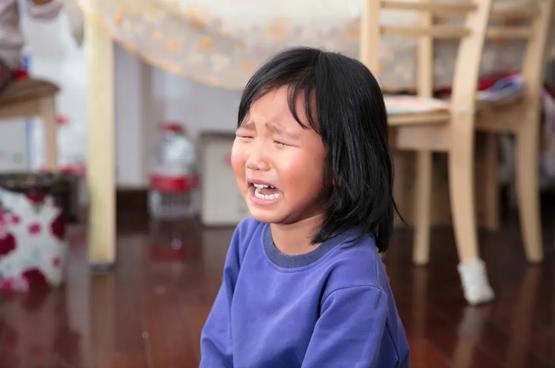
Parents with children hope that everything can go according to plan, as much as possible-the baby is well, and the parents are also well.
But there are always times when the plan can’t keep up with the changes, the changes in life have caught us off guard, and it turns out that the baby is the most sad hurdle.
Children respond to change more emotionally than adults. And some children simply cannot accept the fact that “there is a change”!

Not to mention big changes such as moving, changing kindergarten, entering a new school, and entering a new environment, even small changes in life often make the baby emotionally broken:
- Because of the rain, I couldn’t go to the park for the time being, and my baby collapsed;
- I planned to go to the toy store, but the store closed temporarily, and my baby cried loudly;
- My good friend didn’t come to kindergarten at home, and my baby was sad all day…
Parents also try their best to follow the original plan, but many times it is really “parents can’t do it!”
Why do children have low acceptance of change? How can we make the stubborn child at home understand that “life is always changing”?
Let’s decipher it psychologically before dealing with it.

Why is the child unable to accept the change of plan?
1. The baby’s natural psychological temperament determines
Not to mention, the ability to accept planned changes smoothly is partly due to the type of natural psychological temperament.
Speaking of temperament, it feels like the abstract beauty that people exude from the inside out, and it seems difficult for us to describe it concretely. However, in the field of child psychology, Temperament (Temperament) is real and has specific definitions and descriptions— Temperament determines a child’s emotions and behaviors in dealing with the world, and a child will show her temperament style from birth.

 Picture source丨Tuchong Creative
Picture source丨Tuchong Creative
The researchers Alexander Thomas and Stella Chess discovered that temperament is influenced by nine temperament traits, of which “adaptiveness” is one [1] .
Is it difficult for the children in the family to accept changes in daily routines; it is difficult to transition from one activity to another; it takes longer to adapt to a new environment? Or can you adapt smoothly and quickly when you encounter changes in your schedule or routine; accept new arrangements or new ideas easily, and be very flexible?
These are all related to the child’s “adaptability”.
Even, studies on psychological temperament have shown that for 3-year-old children, children with high adaptability have a longer total sleep time and are less likely to wake up frequently [2] . At the same time, another study found that among the children promoted to elementary school, the children with high adaptability are also those who are more adaptable to campus life in the teacher’s evaluation [3] .
What I want to remind everyone is that there is no good or bad temperament , it just represents each person’s unique style of doing things.
Therefore, whether the adaptation is fast or slow, these performances are normal . “Adaptation” largely determines the child’s behavioral response after the environment changes, and it is also the child’s innate initial reaction to the world.
2. Law and order give children a sense of security
Just like kindergartens have a fixed daily flow, under the fixed flow, children can predict what will happen in a day and know what they can do. For children with limited abilities, a regular and orderly life can bring them a sense of security and control.

 Picture source丨Tuchong Creative
Picture source丨Tuchong Creative
Every child will go through such a stage in his childhood – “order sensitive period”. This sensitive period appeared before the child was 1 year old and lasted until after 2 years old. [5]
“Order sensitive period” refers to a period of time when children are very sensitive to the position and form of objects in their environment.
During this period, children may be more interested in organizing and putting things away than playing with toys. Children very much need an environment with basic rules and stable processes, because their initial thinking is that the world exists with unchanging procedures and orders, and disrupting order will bring children a sense of insecurity. Therefore, children who are sensitive to order will seem to have some “stubbornness”,
3. The child’s brain is a “single tendon”
In our brain development, there is an ability called “cognitive flexibility” (cognitive flexibility) – the brain’s ability to adapt to new, changing and unplanned events, but also to switch from one way of thinking to another Ability.
With the development of children’s brains, especially the development of the frontal lobe of the brain, children will slowly begin to develop the skill of cognitive flexibility during the period of 2-5 years old [4] .
But before this ability can be well mastered, the child’s brain is like a cute “one tendon”, which is completely straight-line thinking.
What is unplanned? What is the change? The baby doesn’t understand. The baby doesn’t accept it.
And when it comes to things like plans falling short, remember that the frontal lobes, which are immature in early childhood, are also people’s emotional processors. Therefore, not only can the children not accept the change of plan, but also! It is also difficult for them to regulate their emotions . They cry, break down, and cannot control their negative emotions. 
 Picture source丨Tuchong Creative
Picture source丨Tuchong Creative
Therefore, whether it is the child’s temperament characteristics or the psychologically sensitive stage, it tells us to provide children with a regular and orderly life routine as much as possible.
But the plan can’t keep up with the changes. When things happen, the child has already collapsed emotionally and can’t accept it, what should I do? You can start with the following two points:

First, help children regulate their emotions
1. Allow the child to be sad and become his emotional “substitute”
Facing the tearful child, you who are also collapsed, will you have the following reaction when you are helpless:
Threateners: “Why cry, I’ll get angry if you cry again!” Rationalists: “Things happen, they happen, and crying can’t change anything.” Compensationists: “Look, it’s closed, and mom and dad didn’t expect it , we are also very surprised, shall we find another chance to accompany you next time?”
Although it is said that apart from the intimidation faction, the rational faction and the compensation faction are also reasonable and trying to solve the problem, but! What we are dealing with is a heartbroken child! Their little heads are neither flexible nor good at regulating emotions, he can’t listen to them!
We all have emotional reactions to sudden changes, and children are no exception. We all need to cry secretly sometimes, let alone children? ! Children also have their own ways of expressing their emotions.

 Picture source丨Tuchong Creative
Picture source丨Tuchong Creative
Although it is a headache to face a crying child, we must firmly believe that every time a child loses control of his emotions, it is an opportunity for us to become a good friend of the child!
The first thing to do is to understand and accept the negative emotions that result from the change:
- “Oh, it’s sad to lose the golden bean. Mom understands you and will accompany you to help you pick the golden bean.”
- “Hug you, I know you are sad that the toy store is closed, so give me a good hug.”
- “Seeing you are so sad, Mom and Dad will be with you.”
Then, show our empathy by telling our kids that we get down because of similar situations:
- “If it were me, I would be very sad too. My mother cried for such things when she was a child.”
- “I was like this once. My mother was going on a trip, but I didn’t catch the plane. I felt bad.”
Emotional kids are all inside their heads, things have changed! I am so sad! Then I found that my parents understand me, they are my emotional “mouth substitutes”, and they are my good friends, so they may be willing to communicate with us and listen to our reasoning.
Therefore, we need to allow our children to grieve and accept their emotions.
2. Involve children in problem-solving
When the child’s mood eases, we can not only be “reasonable” – reasoning ; “compensation” to try to solve the problem , we can also be “auxiliary” – let the child decide how to solve the problem , parents can guide and provide ideas .
This can help children regain a sense of control over their lives and be able to predict what is going to happen. Knowing what you can do will give you peace of mind.
—— “Then the toy store is closed today, what should I do?”
– “I’m going.”
——”If it’s not closed, I’d like to go today too. Please help me figure out how to solve this problem. Shall we go to the mall for a while today? Or come to the toy store next week?” or “We’ll come back on Friday See? Or come back next Saturday?” (give choice)
*You can also brainstorm together, “Let’s think about the solutions together.”
Involving children in the problem-solving process is more effective than making decisions for them.

Then, slowly cultivate the child’s “sense of relaxation”
Cognitive flexibility is actually very close to the concept of “relaxation”, which is very popular recently. Even if there are changes in the plan in life, we can do it without getting angry or collapsing. Think about what else to do.
We said earlier that it is very normal for children to collapse due to changes in plans, so we cannot ask children to have a “sense of relaxation” as soon as they come up. Cultivate your child’s flexibility slowly.
1. Provide A/B plan to children in advance
We can tell the child’s “one tendon” brain in advance that we will have two ways of planning- let the child participate in the formulation of a plan with a plan B.
Especially for those things that are likely to have mood swings and things that are not sure, discuss with your children in advance what can be done with an alternative “Plan B” when “Plan A” doesn’t work? And how do kids deal with their emotions when plans change?
We help “one-track” babies to establish flexible “brain pathways” in advance to cultivate children’s cognitive flexibility.

 Picture source丨Tuchong Creative
Picture source丨Tuchong Creative
2. Make a “Life Change Board” to remind children that life is constantly changing
A simple “life change board” hung on the wall or posted on the refrigerator can record some unpredictable situations and sudden changes.
For example, I was sick and asked for leave, and my classmates were absent from work, the school was suddenly closed, the interest class was canceled, the toy store was closed, it was raining and the outing was canceled, etc…
The information on these “life change boards” is constantly inputting a signal to the child’s brain – life is constantly changing, and plans often fail to keep up with the changes.
3. Let flexibility run through life and games
Parents’ cognitive flexibility has a great impact on children . We usually relax so that children can follow suit.
Play is also a great way to help children develop cognitive flexibility:
- For example, when playing with toys, as long as it is safe, any way of playing is a kind of exploration and practice for children, and we do not need to correct and fix the way children play ;
- For example, when playing games, you can set more flexible game rules. For example, when the music is rhythmic, the music starts to dance, and you temporarily enter the “wooden man” state. You can also occasionally change the settings of dancing and stillness . Children understand that there is more than one way to play a game and more than one way of thinking.
- For example, you can play games with multiple answers with your children, such as when playing a sorting game, apples can be assigned to both fruit and color groups. The answer is not unique, and children can use different perspectives to think about the problem.
- For example, when playing pretend games, you can add the hypothetical situation that “plans can’t keep up with changes” , observe and guide children to deal with similar problems during role-playing.
4. Encourage children’s cognitive flexibility
Whenever your child demonstrates their flexible thinking and behavior, be sure to praise their progress and this behavior. Because for children, the development of such cognitive flexibility is challenging . We need to give children confidence, tell them to think well and do well, and we must remember to give them positive feedback.


Editor 丨Antelope, observer of human cubs.
References丨[1]Chess, S., & Thomas, A. (1984). Origins and evolution of behavior disorders from infancy to early adulthood. New York: Brunner/Mazel. [2]Weissbluth, M. (1984). Sleep duration, temperament, and Conners’ ratings of three-year-old children. Journal of Developmental and Behavioral Pediatrics. [3] Carey, WB, Fox, M., & McDevitt, SC (1977). Temperament as a factor in early school adjustment. Pediatrics, 60(4), 621-624. [4]Deak, GO (2003). The development of cognitive flexibility and language abilities. [5] Maria. Montessori. (2003). Childhood Secret (Montessori Preschool Classics Series). Tianjin People’s Publishing House.
Related Reading
-
“Mom and Dad, why do you have to bring a knife when you talk, and cut me all over again and again?”
-
He offered his full-time wife a monthly salary of 22,000 yuan, but netizens quarreled…
-
How many men say they buy toys for their babies, but they actually buy them for themselves!
 |Author Recruitment & Submission| Backstage reply to “Submission”, check details Submission email: [email protected]
|Author Recruitment & Submission| Backstage reply to “Submission”, check details Submission email: [email protected]

This article is transferred from: http://www.guokr.com/article/462998/
This site is only for collection, and the copyright belongs to the original author.